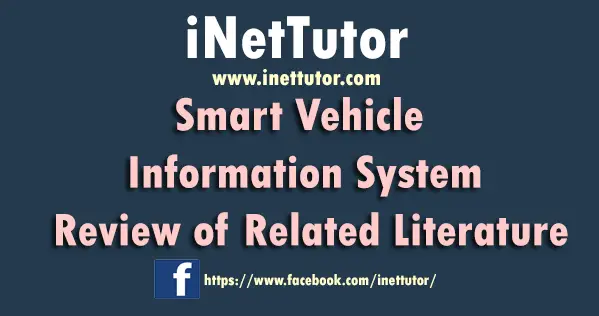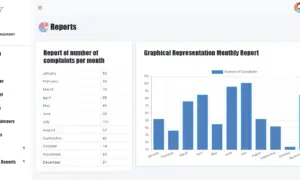Smart Vehicle Information System Review of Related Literature
The project entitled Smart Vehicle Information System is a web based database driven application that will monitor and records the renewal/franchise processing, information of the vehicle and owner as well as the violations committed. Report generation and other transactions may also be incorporated in the said project.

REVIEW OF RELATED LITERATURE, STUDIES, AND PRIOR ART SEARCH
This chapter presents the related literature and studies that help the researcher in developing the proposed system.
Smart Vehicle Identification System
The present invention relates to a smart vehicle identification device that has means to determine the identity of vehicles on city streets and highways. The smart vehicle identification device comprises of 1) an interrogator in the form of a radio frequency (RF) reader; 2) wireless transceiver, modem and communication ports that serve as communication means; 3) a central processing unit comprising of a processor and memory chip that determines and controls the functioning of the smart vehicle identification device. A multitude of smart vehicle identification devices are placed strategically along highways and city streets: and each smart vehicle identification device communicates with a central control station to form a network. Transponders; comprising of radio frequency (RF) tags; are mounted on vehicles and contain vehicle identification device has means to interrogate the RF tag of vehicles passing through its corresponding interrogation zone on highways and city streets. Vehicle identification information thus obtained is transmitted to the central control station. Suspect vehicle identification information is entered into computer system at the central control station; which has means to match the entered suspect vehicle identification information with the vehicle identification information obtained from the smart vehicle identification devices in its network; and determine if a suspect vehicle has been identified by a smart vehicle identification device in its network. Law enforcement officials are alerted if a suspect vehicle is identified (encrypted.google.com).
Vehicle Sharing System
According to Andrea G. Bianchessi, Carlo Ongini and Giovanni Alli (2013), in this work a review of the technological aspects of Vehicle Sharing Systems is given. First a definition of Vehicle Sharing System is provided; then the main problems related to these kinds of systems are introduced by comparing different solutions both presented in literature and currently used by Vehicle Sharing Systems companies. System infrastructure, fleet management and user interaction aspects are discussed in detail. Finally, a bunch of Vehicle Sharing Systems initiatives are introduced and synthetically compared. (ieeexplore.ieee.org)
Vehicle Park with renewable energy
In 2017, Power oscillations can result from the expansion of large-scale grid-connected Electric Vehicles (EV) parks fed from photovoltaic (PV) arrays which raising concerns about grid stability. This paper addresses the optimal sizing for the energy storage battery, its corresponding DC-DC power converter and the grid tie inverter to satisfy grid requirements and maximize the profit of a EV park owner under the utility constraints. This was achieved through two stages: probabilistic forecasting of the EV load pattern and optimal sizing of the battery and power converters by the aid of linear programming (LP). Three types of batteries were studied to support the EV Park: Sodium Sulfur (NaS), Lead Acid (LA) and Vanadium-Redox (VR). Moreover, a sensitivity analysis was done by investigating the effect of changing the number of grid tie inverters. Results showed the effectiveness of the proposed solution in limiting the power oscillations at the point of common coupling with the grid and maximizing the EV Park’s owner profit. Results also revealed the superiority of the VR battery for a low number of grid tie inverters while LA was preferable for implementing higher numbers of grid tie inverters on the host grid while limiting the power fluctuations at the grid side (ieeexplore.ieee.org).
Related Studies
An improved MPPT interleaved boost converter for solar electric vehicle application
An interleaved boost dc/dc converter is developed featuring smaller input/output filters, faster dynamic response and lower device stress than conventional designs, for solar electric vehicle (SEV) applications. The converter is connected between the photovoltaic power generation and dc bus in a multisource energy storage system of a SEV. Typically, interleaved converters require a current control loop to reduce the input current ripples, the output voltage ripples, and the size of passive components with high efficiency. A Maximum Power Point Tracking (MPPT) controller for a Photovoltaic (PV) solar system associated to backup source (Battery) guarantees an uninterrupted power supply and assist the propulsion of the vehicle during transients and recover energy during regenerative braking. The design, construction, and testing of an experimental hardware prototype is presented, with the test results included.
(ieeexplore.ieee.org).
Synthesis
The related literature and studies provides great bases on the development of Smart Vehicle Information System. There were a lot of related studies discussed with the transition of many organizations from different practices to social platforms especially in vehicle identification devices. The related literature discussed about the preventing and monitoring in the highways or road and on how to manage the office to come up with the good quality service. The related studies and literature reminds the researcher in considering the office condition to operate efficiently.
You may visit our Facebook page for more information, inquiries, and comments. Please subscribe also to our YouTube Channel to receive free capstone projects resources and computer programming tutorials.
Hire our team to do the project.


